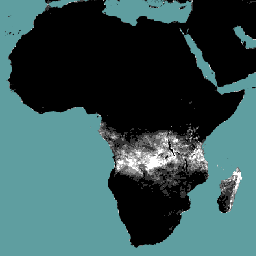
- Veri Kümesi Kullanılabilirliği
- 2009-01-01T00:00:00Z–2025-12-21T00:00:00Z
- Veri Kümesi Sağlayıcı
- FAO UN
- Adım frekansı
- 10 gün
- Etiketler
Açıklama
Yakalanan yağmur suyu bileşeni (I) (on günlük, mm/gün cinsinden), bitki örtüsü tarafından yakalanan yağmur suyunun buharlaşmasını ifade eder. Yağmurun yapraklar tarafından tutulmasına yağmur tutma denir. Bu yağmur suyunun bir kısmı tekrar buharlaşır. Her pikselin değeri, söz konusu dekad için ortalama günlük buharlaşan yağmur suyu miktarını gösterir.
Bantlar
Piksel Boyutu
248,2 metre
Bantlar
| Ad | Birimler | Ölçek | Piksel Boyutu | Açıklama |
|---|---|---|---|---|
L1-I-D |
mm | 0,1 | metre | Yakalanan yağış (Dekadal) [mm] |
Kullanım Şartları
Kullanım Şartları
Birleşmiş Milletler Gıda ve Tarım Örgütü (FAO), beslenme, gıda ve tarımla ilgili bilgileri toplamak, analiz etmek, yorumlamak ve yaymakla görevlidir. Bu bağlamda, FAO'nun yetki alanıyla ilgili konularda bir dizi veritabanı yayınlar ve bunların bilimsel ve araştırma amaçlı kullanımını teşvik eder. Open Data Licensing For Statistical Databases (İstatistik Veritabanları İçin Açık Veri Lisanslama) kapsamında öngörülen açıklık ve paylaşım ilkeleriyle tutarlı olarak ve FAO'nun yetkisiyle uyumlu şekilde, AQUASTAT'ın (FAO'nun Su ve Tarım Konusundaki Küresel Bilgi Sistemi) bir parçası olan Water Productivity Open Access Portal (WaPOR)'daki veriler kullanıcı topluluğuna ücretsiz olarak sunulur.
Alıntılar
FAO 2023. WaPOR Database Methodology: Level 1. Su Verimliliği İçin Uzaktan Algılama Teknik Rapor: Metodoloji Serisi. Roma, FAO. 72 sayfa
FAO 2023. WaPOR V3 Veritabanı Metodolojisi. Su Verimliliği İçin Uzaktan Algılama Teknik Raporu: Metodoloji Serisi. Rome, FAO. https://www.fao.org/3/cc6964en/cc6964en.pdf
Earth Engine ile keşfetme
Kod Düzenleyici (JavaScript)
var coll = ee.ImageCollection('FAO/WAPOR/3/L1_I_D'); var image = coll.first(); Map.setCenter(17.5, 20, 3); Map.addLayer(image, {min: 0, max: 50});
